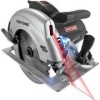Craftsman 7-1/4 Operation Manual - Page 11
nearest Sears Service Center or - compound miter saw
 |
View all Craftsman 7-1/4 manuals
Add to My Manuals
Save this manual to your list of manuals |
Page 11 highlights
ADDITIONAL RULES FOR SAFE OPERATION cont. 6. INSPECT the tool cords periodically and if damaged have them repaired at your nearest Sears Service Center or other Authorized Service Facility. BE AWARE of the cord location. 7 ALWAYS check the tool for damaged parts, Before further use of the tool, a guard or other part that is damaged should be carefully checked to determine if it will operate properly and perform its intended function. Check for misalignment or binding of moving parts, breakage of parts, and any other condition that may affect the tool's operation, A guard or other part that is damaged should be properly repaired or replaced at a Sears Service center. 8 INSPECT and remove all nails from lumber before sawing, 9 SAVE THESE INSTRUCTIONS. Refer to them frequently and use them to instruct others who may use this tool. If someone borrows this tool, make sure they have these instructions also. Spindle The shaft on which a blade or cutting tool is mounted. Also called the Arbor. Revolutions Per Minute (RPM) The number of turns completed by a spinning object in one minute. Saw Blade Path The area over, under, behind or in front of the blade, as it applies to the workpiece. That area which will be or has been cut by the blade. Set The distance that the saw blade tooth is bent (or set) outward from the face of the blade Miter Cut A cutting operation made with the blade at any angle other than 900 to the fence. Compound Miter Cut A compound miter cut is a cut made using a miter angle and a bevel angle at the same time Cross cut A cutting or shaping operation made against the grain of the workpiece Bevel Cut A cutting operation made with the blade at any angle other than 900 to the miter table. Dado Cut A non-through cut which produces a square-sided notch or trough in the workpiece (requires special blade). Chamfer Cut A cut removing a wedge from a block of wood so the end (or part of the end) is angled at other than 900. Ripping or Rip Cut A cutting operation along the length of the workpiece. Freehand Cut Performing a cut without using a fence, miter gauge, fixture, work clamp, or other proper device to keep the workpiece from twisting or moving during the cut. Through Sawing Any cutting operation where the blade extends completely through the thickness of the workpiece. 11 -t















